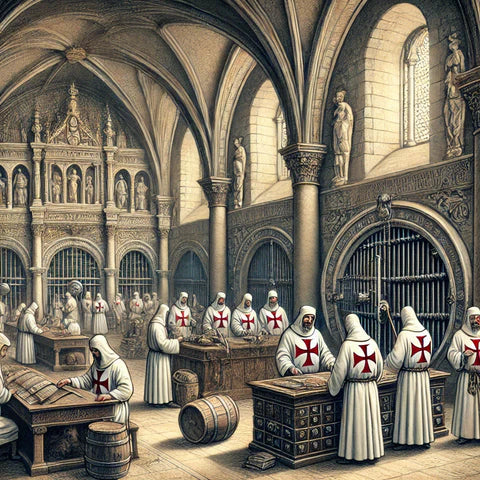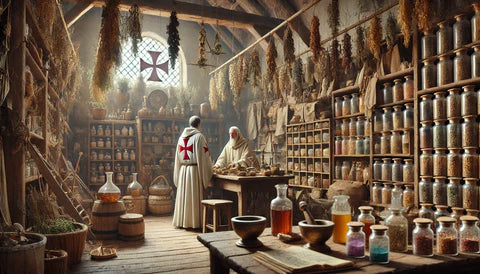The Knights Templar and Their Relations with Other Religious Orders
The Knights Templar, a medieval Christian military order founded in the early 12th century, are often remembered for their martial prowess and their role in the Crusades. However, the Templars were not an isolated group. They interacted with various other religious orders, shaping and being shaped by these relationships. Understanding the Templars’ connections with other orders offers a more nuanced picture of their role within the broader tapestry of medieval Christendom.
The Origins of the Knights Templar and Their Mission
The Knights Templar were established around 1119 to protect Christian pilgrims traveling to the Holy Land after the First Crusade. With a dual identity as both monks and warriors, the Templars took monastic vows of poverty, chastity, and obedience, and they committed themselves to the defense of Christendom. Over time, they became one of the most powerful military and financial institutions of the medieval period, accumulating significant wealth and political influence.

Relations with the Knights Hospitaller: Allies and Rivals
The Knights Hospitaller, also known as the Order of Saint John, were another prominent military order founded around the same time as the Templars. Originally established to provide care for sick and wounded pilgrims in Jerusalem, the Hospitallers also took on a military role, defending Christian territories in the Holy Land.
While both the Templars and Hospitallers shared similar missions of protecting pilgrims and defending the Crusader states, their relationship was marked by both cooperation and rivalry. The two orders often collaborated on the battlefield, joining forces against common enemies such as the Muslim forces in the Levant. Their joint efforts were crucial in defending key Crusader outposts, such as the fortified city of Acre.
However, this cooperation was sometimes overshadowed by competition for resources, recruits, and political influence. The Templars and Hospitallers often found themselves vying for the same donations of land and money from European nobility, leading to tensions. Their rivalry was particularly evident in the cities where they both had a significant presence, such as Jerusalem and Acre, where disputes over property and privileges occasionally erupted into open conflict.

Interactions with the Cistercians: Spiritual Guidance and Influence
The Cistercians, a monastic order known for their emphasis on simplicity, austerity, and strict adherence to the Rule of Saint Benedict, had a significant influence on the Knights Templar. Saint Bernard of Clairvaux, one of the leading figures of the Cistercian order, played a crucial role in shaping the spiritual character of the Templars. He was a fervent advocate for the Templar cause, and his writings, such as the influential "In Praise of the New Knighthood," provided theological justification for the existence of a military order of monks.
The close relationship between the Templars and the Cistercians was not just spiritual but also practical. Many early Templar leaders were closely associated with the Cistercian order, and the Templars often looked to the Cistercians for spiritual guidance and support. This relationship helped the Templars maintain a strong monastic identity despite their martial activities.
However, this close relationship could also lead to tension. As the Templars grew in wealth and power, some Cistercians began to criticize the Templars for straying from their vows of poverty and simplicity. Despite these occasional critiques, the bond between the two orders remained strong, with the Cistercians continuing to provide spiritual counsel to the Templars throughout their existence.

Relations with the Teutonic Knights: Shared Purpose and Divergent Paths
The Teutonic Knights, a German military order founded during the late 12th century, shared many similarities with the Templars. Like the Templars, the Teutonic Knights were initially formed to aid Christians in the Holy Land and to protect pilgrims. However, as the Crusader states in the Holy Land began to fall, the Teutonic Knights shifted their focus to the Baltic region, where they embarked on campaigns to Christianize the pagan peoples of Eastern Europe.
The Templars and Teutonic Knights interacted primarily during the Crusades in the Holy Land, where they occasionally collaborated on military campaigns. However, their different geographical focuses and cultural backgrounds meant that their paths diverged significantly over time. While the Teutonic Knights established a powerful monastic state in Prussia, the Templars continued to concentrate their efforts on defending the remnants of the Crusader states in the Levant.
Despite these differences, the Templars and Teutonic Knights maintained a sense of camaraderie and mutual respect, often recognizing each other’s contributions to the broader Crusader cause. This mutual recognition was especially important as the Templars faced increasing pressure from European monarchs and the Catholic Church in the early 14th century.
The Dominicans and Franciscans: Theological Influences and Conflict
The mendicant orders, particularly the Dominicans and Franciscans, also played a significant role in the religious landscape of medieval Europe. These orders, which emerged in the early 13th century, emphasized poverty, preaching, and a commitment to serving the poor. The Dominicans, in particular, were heavily involved in the Inquisition and were tasked with rooting out heresy within Christian lands.
The Templars, who by this time had accumulated significant wealth and political power, sometimes found themselves at odds with the mendicant orders, whose emphasis on poverty and humility contrasted sharply with the Templars’ opulence. The Dominicans, with their focus on doctrinal purity, were often critical of the Templars, especially as accusations of heresy and corruption began to emerge against the order in the early 14th century.
This tension came to a head during the trial of the Templars, when the Dominican-led Inquisition played a central role in interrogating and prosecuting members of the order. The Franciscans, on the other hand, were less directly involved in the Templars’ downfall, but their growing influence in the Church and their commitment to poverty further highlighted the stark contrast between the Templars’ monastic origins and their later accumulation of wealth.

The Fall of the Templars and the Impact on Other Orders
The dissolution of the Knights Templar in 1312 by Pope Clement V, under pressure from King Philip IV of France, had far-reaching consequences for other religious orders. The wealth and properties of the Templars were largely transferred to the Hospitallers, significantly increasing their power and influence. This transfer of resources, however, did not come without complications, as the Hospitallers had to navigate the complex political and legal challenges associated with taking over former Templar assets.
For the Teutonic Knights, the fall of the Templars underscored the dangers of accumulating too much power and wealth, prompting them to tread carefully in their dealings with European monarchs and the Papacy. The mendicant orders, particularly the Dominicans, saw their role in the Templars’ trial as a reaffirmation of their commitment to doctrinal purity and their influence within the Church.

Conclusion
The Knights Templar were far more than just a military order; they were an integral part of the religious and political fabric of medieval Europe. Their interactions with other religious orders were complex, marked by cooperation, competition, and conflict. These relationships not only shaped the Templars’ history but also influenced the broader Christian world of the Middle Ages.
By examining the Templars' relations with other orders, we gain a deeper understanding of the multifaceted nature of medieval Christendom and the interconnectedness of its various religious institutions. The Templars’ legacy, intertwined with those of the Hospitallers, Cistercians, Teutonic Knights, Dominicans, and Franciscans, continues to captivate the imagination, reminding us of a time when faith, power, and ambition were inextricably linked.









